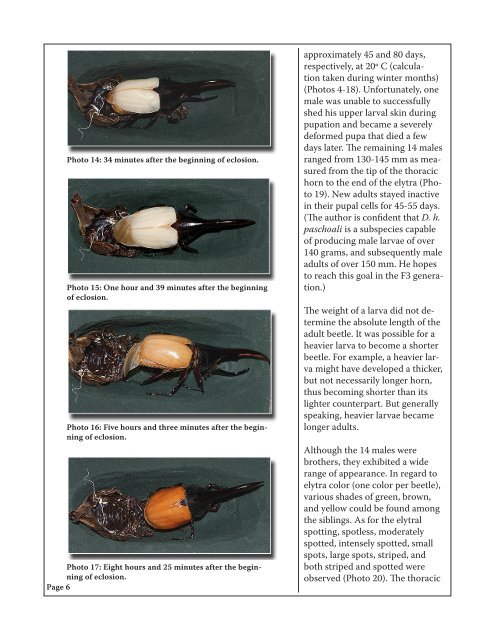Scara b s - University of Nebraska State Museum
Scara b s - University of Nebraska State Museum
Scara b s - University of Nebraska State Museum
You also want an ePaper? Increase the reach of your titles
YUMPU automatically turns print PDFs into web optimized ePapers that Google loves.
Photo 14: 34 minutes after the beginning <strong>of</strong> eclosion.<br />
Photo 15: One hour and 39 minutes after the beginning<br />
<strong>of</strong> eclosion.<br />
Photo 16: Five hours and three minutes after the beginning<br />
<strong>of</strong> eclosion.<br />
Photo 17: Eight hours and 25 minutes after the beginning<br />
<strong>of</strong> eclosion.<br />
Page 6<br />
approximately 45 and 80 days,<br />
respectively, at 20º C (calculation<br />
taken during winter months)<br />
(Photos 4-18). Unfortunately, one<br />
male was unable to successfully<br />
shed his upper larval skin during<br />
pupation and became a severely<br />
deformed pupa that died a few<br />
days later. The remaining 14 males<br />
ranged from 130-145 mm as measured<br />
from the tip <strong>of</strong> the thoracic<br />
horn to the end <strong>of</strong> the elytra (Photo<br />
19). New adults stayed inactive<br />
in their pupal cells for 45-55 days.<br />
(The author is confident that D. h.<br />
paschoali is a subspecies capable<br />
<strong>of</strong> producing male larvae <strong>of</strong> over<br />
140 grams, and subsequently male<br />
adults <strong>of</strong> over 150 mm. He hopes<br />
to reach this goal in the F3 generation.)<br />
The weight <strong>of</strong> a larva did not determine<br />
the absolute length <strong>of</strong> the<br />
adult beetle. It was possible for a<br />
heavier larva to become a shorter<br />
beetle. For example, a heavier larva<br />
might have developed a thicker,<br />
but not necessarily longer horn,<br />
thus becoming shorter than its<br />
lighter counterpart. But generally<br />
speaking, heavier larvae became<br />
longer adults.<br />
Although the 14 males were<br />
brothers, they exhibited a wide<br />
range <strong>of</strong> appearance. In regard to<br />
elytra color (one color per beetle),<br />
various shades <strong>of</strong> green, brown,<br />
and yellow could be found among<br />
the siblings. As for the elytral<br />
spotting, spotless, moderately<br />
spotted, intensely spotted, small<br />
spots, large spots, striped, and<br />
both striped and spotted were<br />
observed (Photo 20). The thoracic
















